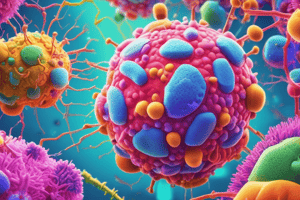Podcast
Questions and Answers
Beta-lactams are a class of antibiotics that inhibit bacterial growth by directly interfering with which cellular process?
Beta-lactams are a class of antibiotics that inhibit bacterial growth by directly interfering with which cellular process?
- Replication of bacterial DNA
- Synthesis of mycolic acid in the cell wall
- Transpeptidation during cell wall synthesis (correct)
- Ribosomal RNA within the 30S subunit
Glycopeptide antibiotics, such as Vancomycin, are effective against Gram-positive bacteria because they primarily target:
Glycopeptide antibiotics, such as Vancomycin, are effective against Gram-positive bacteria because they primarily target:
- The outer membrane porins to disrupt membrane integrity
- The synthesis of 23S rRNA in the 50S ribosomal subunit
- The D-ala-D-ala stem of peptidoglycan precursors (correct)
- The activity of DNA gyrase, preventing DNA supercoiling
Lipopeptide antibiotics, exemplified by Daptomycin, disrupt bacterial cell membrane integrity through:
Lipopeptide antibiotics, exemplified by Daptomycin, disrupt bacterial cell membrane integrity through:
- Blocking the binding of tRNA to the 16S rRNA
- Inhibition of RNA polymerase beta subunit
- Interference with the production of tetrahydrofolate
- Depolarization of the cell membrane (correct)
Polymyxins are known for their activity against Gram-negative bacteria. Their mechanism of action involves:
Polymyxins are known for their activity against Gram-negative bacteria. Their mechanism of action involves:
Aminoglycosides are a class of antibiotics that interfere with protein synthesis by:
Aminoglycosides are a class of antibiotics that interfere with protein synthesis by:
Tetracyclines inhibit bacterial protein synthesis by specifically:
Tetracyclines inhibit bacterial protein synthesis by specifically:
Macrolide antibiotics, such as Erythromycin, target protein synthesis by interacting with:
Macrolide antibiotics, such as Erythromycin, target protein synthesis by interacting with:
Oxazolidinones, like Linezolid, are effective against Gram-positive bacteria because they inhibit protein synthesis by:
Oxazolidinones, like Linezolid, are effective against Gram-positive bacteria because they inhibit protein synthesis by:
Fluoroquinolones are a class of antibiotics that target bacterial DNA replication by:
Fluoroquinolones are a class of antibiotics that target bacterial DNA replication by:
Metronidazole is specifically effective against anaerobic bacteria because its mechanism of action involves:
Metronidazole is specifically effective against anaerobic bacteria because its mechanism of action involves:
Rifampin is an antibiotic that inhibits bacterial transcription by targeting:
Rifampin is an antibiotic that inhibits bacterial transcription by targeting:
Sulfonamide antibiotics inhibit the synthesis of tetrahydrofolate by acting as a competitive inhibitor of:
Sulfonamide antibiotics inhibit the synthesis of tetrahydrofolate by acting as a competitive inhibitor of:
Trimethoprim, often used in combination with sulfamethoxazole, also targets tetrahydrofolate synthesis by inhibiting:
Trimethoprim, often used in combination with sulfamethoxazole, also targets tetrahydrofolate synthesis by inhibiting:
Isoniazid, a pro-drug used to treat Mycobacterium tuberculosis, primarily targets:
Isoniazid, a pro-drug used to treat Mycobacterium tuberculosis, primarily targets:
Nitroimidazole antibiotics, similar to Isoniazid in their target pathway against Mycobacterium tuberculosis, also inhibit:
Nitroimidazole antibiotics, similar to Isoniazid in their target pathway against Mycobacterium tuberculosis, also inhibit:
Diarylquinoline drugs, such as Bedaquiline, are used to treat tuberculosis by specifically inhibiting:
Diarylquinoline drugs, such as Bedaquiline, are used to treat tuberculosis by specifically inhibiting:
Resistance to beta-lactam antibiotics is commonly mediated by bacterial mechanisms including:
Resistance to beta-lactam antibiotics is commonly mediated by bacterial mechanisms including:
The spectrum of activity for Beta-lactam antibiotics is generally described as:
The spectrum of activity for Beta-lactam antibiotics is generally described as:
Which of the following is an example of a Glycopeptide antibiotic?
Which of the following is an example of a Glycopeptide antibiotic?
Macrolide antibiotics are known to have a broad spectrum of activity, but are particularly noted for their effectiveness against:
Macrolide antibiotics are known to have a broad spectrum of activity, but are particularly noted for their effectiveness against:
Flashcards
Beta-lactams Mechanism
Beta-lactams Mechanism
Inhibit transpeptidation by inactivating cell wall transpeptidases.
Examples of Beta-lactams
Examples of Beta-lactams
Penicillin, Cephalosporin, Carbapenem, Monobactam.
Glycopeptides/Lipoglycopeptides Mechanism
Glycopeptides/Lipoglycopeptides Mechanism
Inhibit transpeptidation by binding to D-ala-D-ala stem.
Examples of Glycopeptides/Lipoglycopeptides
Examples of Glycopeptides/Lipoglycopeptides
Signup and view all the flashcards
Lipopeptides Mechanism
Lipopeptides Mechanism
Signup and view all the flashcards
Example of Lipopeptides
Example of Lipopeptides
Signup and view all the flashcards
Polymyxins Mechanism
Polymyxins Mechanism
Signup and view all the flashcards
Example of Polymyxins
Example of Polymyxins
Signup and view all the flashcards
Aminoglycosides Mechanism
Aminoglycosides Mechanism
Signup and view all the flashcards
Example of Aminoglycosides
Example of Aminoglycosides
Signup and view all the flashcards
Tetracyclines Mechanism
Tetracyclines Mechanism
Signup and view all the flashcards
Examples of Tetracyclines
Examples of Tetracyclines
Signup and view all the flashcards
Macrolides Mechanism
Macrolides Mechanism
Signup and view all the flashcards
Example of Macrolides
Example of Macrolides
Signup and view all the flashcards
Oxazolidinones Mechanism
Oxazolidinones Mechanism
Signup and view all the flashcards
Example of Oxazolidinones
Example of Oxazolidinones
Signup and view all the flashcards
Fluoroquinolones Mechanism
Fluoroquinolones Mechanism
Signup and view all the flashcards
Example of Fluoroquinolones
Example of Fluoroquinolones
Signup and view all the flashcards
Isoniazid (Pro-Drug) and Nitroimidazole Mechanism
Isoniazid (Pro-Drug) and Nitroimidazole Mechanism
Signup and view all the flashcards
Example of Diarylquinoline
Example of Diarylquinoline
Signup and view all the flashcards
Study Notes
- Study notes on cell target, class, mechanism, spectrum, resistance, and examples of antimicrobials
Cell Wall
- Beta-lactams inhibit transpeptidation by inactivating cell wall transpeptidases, effective against Gram-positive and Gram-negative bacteria (G+/G-).
- Resistance mechanisms: OM barrier, efflux, β-lactamase production, and target modification (PBPs).
- Examples: Penicillin, Cephalosporin, Carbapenem, and Monobactam.
- Glycopeptides and Lipoglycopeptides inhibit transpeptidation by binding to the D-ala-D-ala stem, primarily effective against Gram-positive bacteria (G+).
- Resistance mechanisms: OM barrier and D-ala-D-lac substitute.
- Examples: Vancomycin, Dalbavancin, and Oritavancin.
Cell Membrane
- Lipopeptides cause membrane depolarization, effective against Gram-positive bacteria (G+).
- Resistance mechanism involves membrane alteration.
- Example: Daptomycin.
- Polymyxins bind LPS and insert into the outer (OM) and inner membranes (IM) of Gram-negative bacteria (G-).
- Resistance mechanisms: LPS modification and efflux.
- Example: Colistin.
Protein Synthesis
- Aminoglycosides bind to 16S rRNA in the 30S ribosomal subunit, exhibiting broad-spectrum activity.
- Resistance mechanisms: Antibiotic inactivation and efflux.
- Example: Gentamicin.
- Tetracyclines bind to 16S rRNA in the 30S ribosomal subunit, showing broad-spectrum activity.
- Resistance mechanisms: Efflux and ribosome protection.
- Examples: Doxycycline and Tigecycline.
- Macrolides bind to 23S rRNA in the 50S ribosomal subunit, exhibiting broad-spectrum activity.
- Resistance mechanisms: Efflux and 23S rRNA methylation.
- Example: Erythromycin.
- Oxazolidinones bind to 23S rRNA in the 50S ribosomal subunit, effective against Gram-positive bacteria (G+).
- Resistance mechanisms: Efflux and 23S rRNA methylation.
- Example: Linezolid.
DNA Replication
- Fluoroquinolones bind to DNA gyrase, displaying broad-spectrum activity.
- Resistance mechanisms: Efflux and gyrase mutation.
- Example: Ciprofloxacin.
- Metronidazole nicks bacterial DNA, effective against anaerobic bacteria.
- Resistance mechanisms: Failure to activate and reduction in flavodoxin expression.
- Example: Flagyl.
Transcription
- Rifampin binds to the β subunit of RNA polymerase, exhibiting broad-spectrum activity.
- Resistance mechanisms: RNA polymerase mutation and efflux.
- Example: Rifampicin.
- Macrocyclic Macrolides inhibit RNA polymerase, effective against C. difficile.
- Resistance: None reported yet
- Example: Difficid
Tetrahydrofolate
- Sulfonamides inhibit PABA to FH₂ (PABA mimic), displaying broad-spectrum activity.
- Resistance mechanisms: Enzyme mutation and efflux.
- Examples: Bactrim and Septra.
- Trimethoprim inhibits FH₂ to FH₄ (FH₂ mimic), exhibiting broad-spectrum activity.
- Resistance mechanisms: Enzyme mutation and efflux.
- Examples: Bactrim and Septra.
Mycolic Acid
- Isoniazid (Pro-Drug) inhibits mycolic acid synthesis, effective against Mycobacterium tuberculosis (M. tb.).
- Resistance mechanism: Failure to activate, KatA.
- Example: Isoniazid.
- Nitroimidazole inhibits mycolic acid synthesis, effective against M. tb.
- Example: Pretomanid
ATP Synthase
- Diarylquinoline inhibits ATP synthase, effective against M. tb.
- Example: Bedaquiline.
Studying That Suits You
Use AI to generate personalized quizzes and flashcards to suit your learning preferences.




